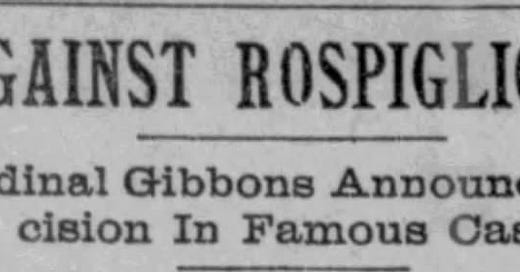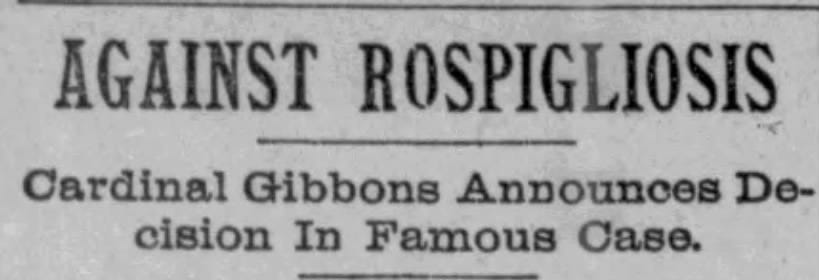NB: Although fascinated by this now obscure case, I excluded the following from my biography of Bishop Bonaventure Broderick because I decided it was too tangential. If you have the book this would have landed in “Chapter 5: Rumors and the Grave Misunderstanding” had I included it.
+++
In addition to Cardinal Gibbons, Archbishop Placide Louis Chapelle of New Orleans became a Broderick antagonist. Gibbons and Chapelle are the central figures in this case of canon law which was tied up in the Vatican over two pontificates. A glance at this case will illustrate their close relationship, an association that may help to explain the ease with which they teamed up against Broderick.
Though separated by great distance during an era of difficult travel, Chapelle in New Orleans, and Gibbons in Baltimore, the two had close ties to each other and to Baltimore where both were ordained as priests and later as bishops.
Chapelle, born in France in 1842, was ordained a priest in Baltimore in 1865. In 1891 he was appointed Coadjutor Archbishop in Santa Fe, New Mexico, ascending to Archbishop in 1894. His principal consecrator was Gibbons. He became Archbishop of New Orleans in 1897, a position he held when he was appointed apostolic delegate to Cuba and the Philippines. Again, his principal consecrator was Gibbons.
Gibbons, a Baltimore native born in 1834, was ordained there in 1861. He, like Broderick, became a bishop at age 34; at the time of their respective appointments each was the youngest American bishop. His episcopacy began as Vicar Apostolic of North Carolina, from there to Bishop of Richmond, Virginia in 1872; then to Baltimore, first as coadjutor archbishop, and within months, as archbishop in 1877. Ten years later he was appointed a cardinal.
Chapelle was assigned to the Cathedral of St. Matthew the Apostle in Washington from 1882 to 1891, when Washington was in the Archdiocese of Baltimore and Gibbons was Chapelle’s bishop. While pastor of the cathedral Chapelle presided at a marriage that would end in divorce leaving in its wake legal repercussions from Washington to Rome that dragged on for years and involved a descendant of the family of Pope Clement IX. The litigation became known in the press as “The Famous Rospigliosi Case.”
At the center of the drama was the 1887 marriage of Marie Jennings Reid, a Catholic and New Orleans native, and Colonel Frederick H. Parkhurst, a non-Catholic native of Maine. The couple divorced in 1898, and in 1901 Reid remarried Joseph Rospigliosi, an Italian prince, in a civil ceremony in Rome without obtaining an annulment of her marriage to Parkhurst. The prince was a member of the famed family that produced two cardinals as well as Clement IX. The groom’s brother, Prince Clementine, head of the papal guard, failed to convince his brother not to marry Reid without an annulment of her first marriage.
The Church declared the marriage of Reid and the prince invalid, and the new husband, smitten with Reid, renounced his birthright. His wife, however, finding “many of the best homes in Rome closed against her,” [i] encouraged her husband to secure the recognition of the Church. Rospigliosi then threatened to create a scandal if the Church did not validate his marriage to the divorcee. The basis of the appeal was his insistence that Chapelle did not obtain the necessary dispensation for Mr. Parkhurst, and that Miss Reid married Mr. Parkhurst without knowing that he was not of the Catholic faith. The appeal included a claim that Parkhurst was not even Christian, let alone non-Catholic.
The case drew international attention for years and was followed closely by the press, especially in the hometowns of the two prelates. In 1902, the Baltimore Sun reported:
The life romance of the dashing and beautiful daughter of S. C. Reid, of New Orleans, who spent the greater part of his life in Washington, has furnished material for conversation and discussion on two continents. Before her civil marriage to Prince Rospigliosi of the great house of which at least one member has been seated on the Papal throne, she as Miss Reid and again as Mrs. Parkhurst, was one of the most attractive and popular girls of New Orleans, Washington, Philadelphia and Bar Harbor. The case has always been given much attention here, not only because she had many friends in this city, but chiefly because, the Cardinal's residence being here, those interested in the struggle of the Princess for the sanction of the church for her second marriage naturally looked there for information regarding the progress of the case in Rome.
And in 1903, the New Orleans Times-Democrat, in an article datelined “Special Cable to the Times-Democrat, Rome, February 4,” prophesied that Chapelle’s testimony would free the prince and his bride:
It is believed that the Vatican congregational council will confirm the American divorce which freed Mrs. Marie Reed Parkhurst from Col. Frederick II. Parkhurst of Bangor, Maine and enabled her to become the wife of Prince Joseph Rospigliosi, after a religious ceremony here, and that she will be received by the Roman aristocracy. When the Prince first applied to the congregational council for recognition of his wife's divorce, the church declined to recognize it, but Mgr. Chapelle who married Mrs. Parkhurst to her first husband, has appeared before the congregation and declared that the first marriage was irregular according to the laws of the church.
Contrary to the outcome predicted, Chapelle’s testimony was not accepted by the Vatican and the case lingered until 1905, when, oddly, just ten days after Chapelle’s untimely death of yellow fever, Gibbons announced that an unexpected discovery had been made in the Baltimore chancery: evidence that Chapelle had indeed issued the proper dispensation in 1887 and Reid’s first marriage was valid, and her subsequent divorce disallowed. [ii]
Chapelle’s death came only months after Broderick’s exile began, an exile influenced by both he and Gibbons. No doubt the close relationship between the two affected their joint disfavor of Bishop Broderick and their collaborative effort against him.
[i] “Pius Decided Against Her,” Kansas City Star, June 18, 1905, 4.
[ii] “Against Rospigliosi,” Baltimore Sun, August 21, 1905, 12.
FYI: The case is addressed at length in John T. Noonan, Jr.’s Power to Dissolve: Lawyers and Marriages in the Courts of the Roman Curia (Belknap Press, 1972).





